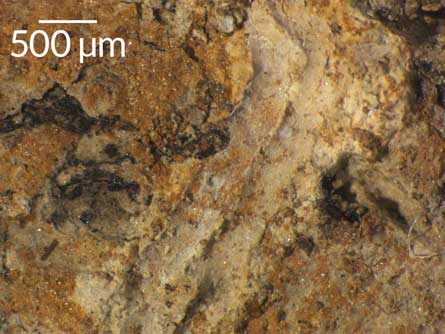Parasites wormed their way into dino’s gut
In the gut of a 77-million-year-old hadrosaur, scientists found tiny tunnels

A 77-million-year-old duck-billed dinosaur nicknamed Leonardo may have carried parasitic worms.
RED ROCKET PHOTOGRAPHY/THE CHILDREN'S MUSEUM OF INDIANAPOLIS/WIKIMEDIA COMMONS (CC BY-SA 3.0)
Share this:
- Share via email (Opens in new window) Email
- Click to share on Facebook (Opens in new window) Facebook
- Click to share on X (Opens in new window) X
- Click to share on Pinterest (Opens in new window) Pinterest
- Click to share on Reddit (Opens in new window) Reddit
- Share to Google Classroom (Opens in new window) Google Classroom
- Click to print (Opens in new window) Print
By Meghan Rosen
Inside the fossilized guts of a 77-million-year-old dinosaur, scientists have spotted a surprise. The dino’s stomach is crisscrossed with thin tunnels. These may be the once-slimy trails of parasitic worms.
Like ticks and fleas, these worms would have been parasites — biological hitchhikers that steal a meal from their host.
These fossil worm tunnels are the first good evidence that gut parasites infected dinosaurs, the scientists say. Paleontologist Justin Tweet and his colleagues described their finding online June 16 in the Journal of Paleontology.
“Maybe they’re right, maybe they’re not,” cautions Anthony Fiorillo. He’s a paleontologist at the Perot Museum of Nature and Science in Dallas, Texas. What looks like worm tracks could be something else entirely, he points out. “But they’re seeing something no one else has seen before, and that’s pretty awesome.”
Animals living today carry parasites and other microscopic life forms in their bodies. Scientists had guessed that dinosaurs did too. “But that doesn’t mean that anybody ever expected to see them,” says Tweet. A former researcher at the University of Colorado Boulder, he now consults for the National Park Service.
Eight years ago, Tweet and his colleagues studied the stomach of a hadrosaur (Brachylophosaurus canadensis) nicknamed Leonardo. Hadrosaurs were plant eaters, also known as duck-billed dinosaurs. Inside Leo’s guts, the scientists saw dark, fingernail-sized flakes. At one time these may have been chewed leaves.

The team also found chemical clues that mucus once lined the tunnels. Tweet thinks tiny worms with fine bristles might have once burrowed in Leonardo’s belly. They may have left behind a fossilized trail of slime.
“Dinosaurs didn’t walk the planet alone,” Fiorillo says. “They were part of an engaged and complicated ecosystem.”
Did other dinosaurs have worms, too? A closer look at more old fossils could reveal the answer, he says. The new paper “illustrates the beauty of the fossil record and how much more we still have to learn from it — if we just keep our eyes open.”







